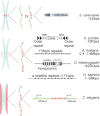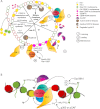CENP-A: the key player behind centromere identity, propagation, and kinetochore assembly
- PMID: 23095988
- PMCID: PMC3501172
- DOI: 10.1007/s00412-012-0386-5
CENP-A: the key player behind centromere identity, propagation, and kinetochore assembly
Abstract
Chromosome segregation is the one of the great problems in biology with complexities spanning from biophysics and polymer dynamics to epigenetics. Here, we summarize the current knowledge and highlight gaps in understanding of the mechanisms controlling epigenetic regulation of chromosome segregation.
Figures




References
-
- Bergmann JH, Rodriguez MG, Martins NM, Kimura H, Kelly DA, Masumoto H, Larionov V, Jansen LE, Earnshaw WC. Epigenetic engineering shows H3K4me2 is required for HJURP targeting and CENP-A assembly on a synthetic human kinetochore. EMBO J. 2011;30(2):328–340. doi: 10.1038/emboj.2010.329. - DOI - PMC - PubMed
Publication types
MeSH terms
Substances
Grants and funding
LinkOut - more resources
Full Text Sources
Other Literature Sources

